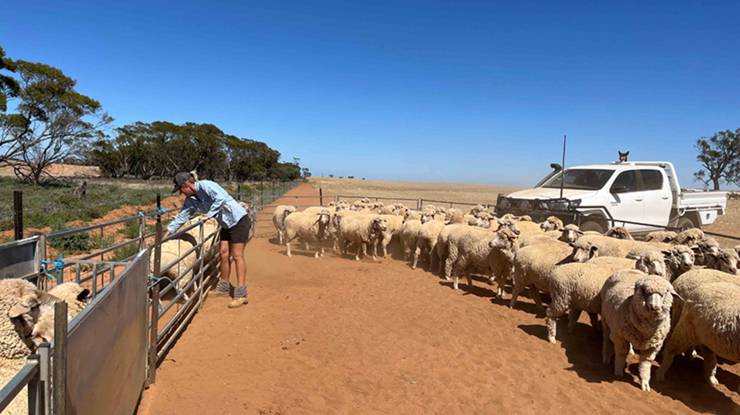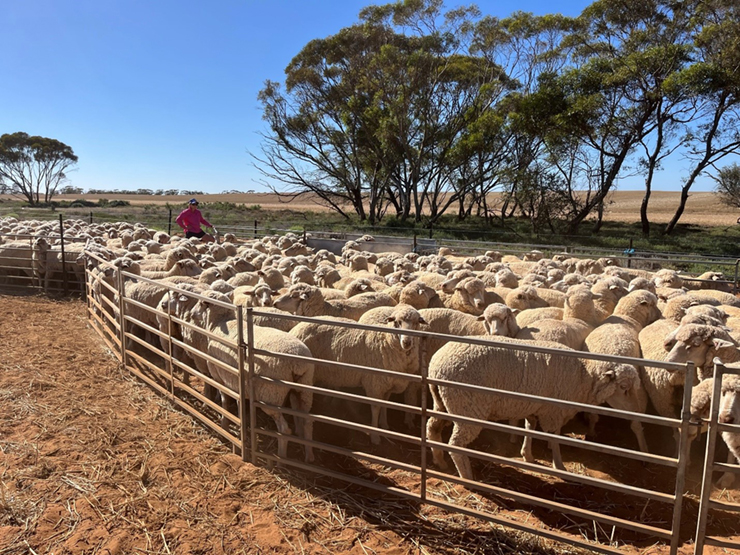 Victorian producer Bec Cruise condition scoring sheep at her family's Carwarp property.
Victorian producer Bec Cruise condition scoring sheep at her family's Carwarp property.
How shifting dates helped Mallee producer cruise through dry
When Bec Cruise and her family reintroduced sheep to their operations after 20 years, things weren’t all as they remembered – and the challenges were quickly revealed in their lambing percentage.
When she came back to the family farm 11 years ago, Bec was eager to return to sheep production, a goal she finally achieved in 2020.
She drew on local knowledge to set up an initial flock management calendar.
“I called around to all the producers in the area, to work out when everyone put their rams in for joining, took them out, when they were shearing etc,” Bec said.
“We followed those dates, but after two years of having to feed during lambing, I thought: ‘Why are we doing it this way?’”
With lambing falling in April – a typically dry period on their Mallee-based farm – Bec realised feeding during lambing would almost always be the normal scenario.
“It wasn’t working. We were bringing in hay and filling up grain feeders – lambs were everywhere, and ewes would leave their lambs to come running after us for feed.”
The resulting lamb mortalities prompted Bec to find a solution.
Creating a new timeline
In a quest for better results, Bec joined a Producer Demonstration Site (PDS), which aims to increase the number of lambs weaned for host farmers by 5–10%, using a combination of practices.
“The PDS coordinators encouraged me to change my lambing calendar to lamb later, when we had more feed.”
With support from the PDS, in 2024 the family started joining rams in mid-February, which moved lambing from April to mid-July.
As expected, the shift meant a change to their entire production calendar, which required careful planning and negotiating of any seasonal consequences.
One of those changes was to the shearing schedule, which was a blessing in disguise.
“We don’t want to be shearing the ewes when they have lambs, so we moved shearing to a couple of weeks after joining,” Bec said.
“We use a neighbour’s shearing shed, so it worked really well having different shearing times.”

Improved lambing
The results of the change became clear at lambing.
From 2023 to 2024, the number of dry ewes decreased by 4% and scanning percentage increased by 24%. Their marking percentage increased by 15% to 126%.
Still, there were challenges.
“Because we now had so much feed during lambing, it went the other way. The lambs were much bigger, so birthing was more challenging,” Bec said.
“Every year is different, so there may not always be that much feed at that time – we’re going to try the same program again this year, but bring the lambing forward one week.
“Moving lambing will avoid some of the cold weather. We want to be finished lambing well and truly before the end of August.”
More changes to come
As part of the PDS, producers are encouraged to implement several practices to improve their production outcomes, including mob size, nutrition, scanning practices, and joining length.
Infrastructure is a priority for the family, as they adjust to having sheep back in their business.
“We have to rebuild fences so we can wean lambs off and then put them on our legume stubbles to finish.
“We want to get them off mum, gain weight and get them sold as soon as possible,” Bec said.
They also trialled teasers (introducing wethers to induce cycling in ewes prior to joining) but with the production calendar shift this became unnecessary as joining later meant ewes were naturally cycling better.
In the long-term, introducing perennial pastures will be a key focus, to eliminate time and costs associated with sowing fodder crops.
Preparing through the PDS
Bec and her family intend to continue operating with the modified production calendar, tackling challenges as they arise.
Beyond the operations support, the PDS involved expert-led workshops and on-farm days to learn about feed and nutrition, lamb autopsies, biosecurity, and other elements to improve lamb production for participants.
Bec attributes the confidence to try something new to her involvement in the PDS.
“When it comes to a big change like this, there are so many factors to manage.
“Having the support and expertise of the PDS coordinators is the only way we could have had the confidence to change the program,” Bec said.
|
Lessons learned
|



